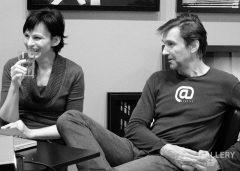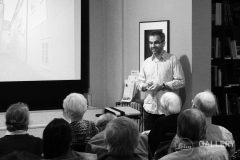One of the pioneers of Czech modern photography and film. He studied photography in Vienna (with professor Rudolf Koppitz) and worked between 1936 and 1938 as a cameraman in Bata’s Zlín, where he collaborated with A. Hackenschmied, E. Klos, J. Lehovec, L. Kolda, K. Plicka and others.
In the thirties Jan Lukas worked for European magazines Lilliput, Der Sonntag and Wiener Tag, as well as for Eva and other Czech periodicals. In 1939 he became a member of the art group The Seven in October (Sedm v říjnu). While it was mainly documentary photography for which he became famous, his work comprises a wide spectrum of genres, from landscapes to reportage to portrait. During his professional career he witnessed many crucial moments of Czechoslovak history: he took pictures of president Edvard Beneš at the time of Munich Agreement and documented the mobilisation of Czechoslovak troops, Nazi occupation, liberation, rise of communism, as well as the oppression of the fifties. These pictures form his essential collection Prague Diary 1938–1965 (Pražský deník 1938–1965). After his emigration in 1965, publication of Jan Lukas’ photos was prohibited in Czechoslovakia. At that time, the collection Italian Diary 1965–1966 (Italský deník 1965–1966) was born, documenting ten months in Italian refugee camps. However, his most famous publication is the 1946 book The Earth and the People (Země a lidé), by which he firmly established himself in the European humanistic photography tradition.
After obtaining US citizenship in 1971, he set to work on the book The Islanders (Ostrované), in which he documented life in Manhattan, Jerusalem, West Berlin and Taiwan. In the US he gained professional recognition – for example, he created covers for the biweekly National Review and took part in the creation of Firing Line TV show. He finished the cycle New York – Pompei (New York – Pompeje), confronting the world of the vanished Italian city Pompei with the colours and nooks and corners of the city he lived in. In 1968 the influential Cornell Capa exhibited his Prague Diary 1938–1965 in the Riverside Museum in New York, reacting in so doing to the Soviet occupation of Czechoslovakia.
The motley mixture of races and cultures, the unique and ever changing atmosphere of the American city, was captured by him in colours as well. In these compositions he advanced his lifetime endeavour to express the beauty, as well as the dark side of the world. Jan Lukas did not revisit his homeland until 1989. His most extensive retrospective ever, Photographic Diary 1930–1990 (Fotografický zápisník 1930–1990), was opened at the Prague Mánes gallery in 1995 by his friend Pavel Tigrid.

